

Performing Arts


Page is proud to welcome Davis Brody Bond to our family. Known for innovative solutions to complex design challenges, Davis Brody Bond brings over 70 years of talent and expertise to our team, inspiring us to Think What’s Possible.

Performance by Design Dynamic spaces that captivate, connect, and spark creative exploration
Designing a performance venue is an art in itself—one that demands more than just technical expertise. It requires an understanding of the complex interplay between space, sound, and emotion. Page’s approach goes beyond the conventional; it’s about creating environments that perform in every sense of the word. From the moment the audience arrives, the venue begins to tell a story, shaping the experience through thoughtful design, versatile spaces, and immersive technologies. Performance isn’t confined to the stage; it’s woven into the fabric of the building, ensuring that every moment, from the opening act to the final curtain, is unforgettable.
AUDIENCE ENGAGEMENT
The design of a performance venue must prioritize the audience experience, ensuring that every seat provides an immersive connection to the stage. Thoughtful seating arrangements, unobstructed sightlines, and seamless accessibility are central to Page’s design philosophy. By creating spaces that foster this connection, audiences become integral to the performance, experiencing every nuance and emotion as intended by the artists.
RADICAL INCLUSIVITY
As cultural hubs, performance venues are vital to community spirit, serving all patrons regardless of age, background, or ability. Page is committed to inclusive design, integrating assistive technologies, championing sensory-friendly spaces, and ensuring accessible seating and intuitive wayfinding. This approach transforms the venue into a center of community engagement, fostering a deep sense of belonging for every visitor.
VERSATILE SPACES
In today’s dynamic arts landscape, performance venues must be adaptable to host a variety of events. Page designs offer the flexibility to transform a space from a concert hall to a theater and accommodate different stage formats such as thrust, round, or end stages. This versatility serves the diverse needs of artists and audiences alike, ensuring that venues remain relevant and functional for years to come.
TECHNOLOGY INTEGRATION
Modern performance venues must integrate state-of-the-art technology to support increasingly complex productions. From advanced lighting and sound systems to innovative projection techniques and stage mechanics, Page leverages the latest technologies to enable immersive experiences. This integration allows for a wide range of creative possibilities, giving artists the tools they need to push boundaries.
ACOUSTIC EXCELLENCE
A performance venue’s success is largely determined by its acoustics. Every sound, from a whispered line to a powerful crescendo, must reach the audience with clarity and precision. Page prioritizes acoustic design to ensure that venues deliver superior sound quality. Through careful consideration of materials, spatial dimensions, and sound dynamics, these spaces enhance the emotional impact of every performance.
SUPPORT SPACES
Behind every performance is a network of essential support spaces facilitating the production process, including scene and costume shops, dressing rooms, and storage for instruments, props, and other essential items. These spaces are functional and inspire creativity, providing performers and crews with everything they need to deliver their best work.
MODERNIZATION AND PRESERVATION
Modernization and preservation are key to maintaining relevance and function in the ever-changing world of performance venues. Page excels at transforming existing buildings into versatile performance venues, but we also have a soft spot for revitalizing historic structures. By blending modern technology, infrastructure, and systems with the original design’s character and integrity, the building retains its iconic status while adapting to the needs of contemporary audiences and performances.
NAVIGATING FINANCIAL LANDSCAPES
The business of theater requires balancing artistic vision with financial sustainability. Venues must navigate complex financial landscapes, managing budgets while optimizing resources. Right-sizing spaces to maximize revenue opportunities, ensuring quick turnarounds to adapt to different events, developing revenue-generating vendor strategies, and delivering cost-effective design solutions culminate in culturally significant and financially viable venues.
SUSTAINABILITY AND LONGEVITY
A high-performing venue is one that stands the test of time, both in function and environmental impact. Page designs with sustainability in mind, employing energy-efficient systems, sustainable materials, and practices that minimize environmental footprint. This commitment to sustainability ensures venues are built not just for today but for future generations. We strive to transform performance venues into vibrant canvases where every high-performing element contributes to a memorable experience, leaving a lasting impression long after the final applause.


New York University
John A. Paulson Center


African Grove Theatre

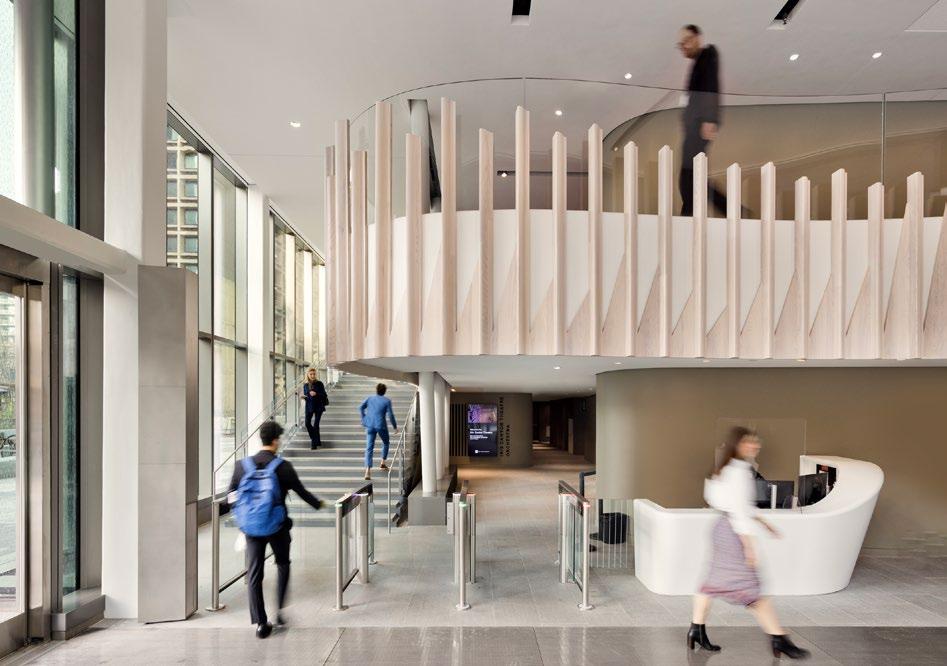
Integrating the performing arts in a multidisciplinary academic environment
The John A. Paulson Center is a 735,000-square-foot mixeduse academic building that addresses New York University’s (NYU) space needs for multiple programs, embodies its character and vibrancy, and offers new ways for the University to engage with its community and the city of New York. Situated at the southern boundary of the main campus, it serves as a new gateway for the University.
Designed to optimize interactions between diverse student groups and academic disciplines, it includes classrooms, informal study spaces, three performing arts theaters, a large rehearsal space and practice rooms for music, varsity sports facilities, a recreational gymnasium, and two food service venues, as well as faculty and first-year student housing. These spaces each belong to a distinct academic neighborhood, which in turn connects to generous perimeter circulation and an open and expansive commons area for collaborative study, meeting, and gathering.
The renowned Tisch School of the Arts and Steinhardt Department of Music are a central component of the multi-use facility, comprising 210,000 sf between the two schools. This new facility provides a diverse range of learning environments for their world-class drama and music programs, with dedicated and collaborative spaces for teaching, learning, rehearsing, and performing. Highlights include:
Iris Cantor Proscenium Theatre
The Cantor Theater is the first professional-level proscenium theater at NYU. It can function as a Broadway-sized stage and fly tower or transform into a music concert hall perfectly sized and tuned to accommodate a wide variety of performances including musical theater, film, spoken word, drama, and orchestral ensembles. Of note:
• 350 seats over three levels
• Features: a fly tower and lighting galleries, stage trap, overhead catwalks, orchestra shell and reflectors, canted throat walls adjacent to the proscenium for acoustic projection, followspot booth, and control booth
• Large, mechanized orchestra lift that allows for various configurations of audience seating and extension of the stage and orchestra pit
• Three floors of lobby space that seamlessly connect to the broader NYU community and theatergoers
Warehouse Theatre
This unique 140-seat experimental theater provides a flexible space for Tisch graduate students to explore innovative performances. It features:
• Use of a Mod-truss system to create the inner box, which is a fully demountable wall system made up of modular, reconfigurable elements
• An overhead catwalk system with movable catwalk trolleys
• Fully reconfigurable seating platforms
African Grove Theatre
Named for the nation’s first black theater, which was founded on this site in 1821, this 140-seat end-stage theater features a range of flexible components that support the Tisch graduate department curriculum, including:
• A flexible seating well that provides opportunities for innovative performances
• Motorized rigging on the stage side with dead-hung, fixed rigging on the audience side
• Movable gantry
Ensemble Rehearsal Room
Flanked by landscaped terraces at the top of the podium, the Ensemble Rehearsal Room sits between two green roofs. The technologically innovative space is the crown jewel of the Steinhardt Department of Music program. It features:
• A double-glazed wall providing visual connection to the city while acoustically separating the spaces from the noisy exterior environment
• Slatted, faceted walls to help control the acoustic quality in the space
• Acoustic banners along the perimeter to absorb sound and create different types of acoustic environments
• Adjacent control booth doubles as a recording studio
Building approach looking north from SoHo
Accessible performing arts lobby


Theater and Music Support Spaces
In addition to the dedicated theater spaces and the Ensemble Rehearsal Room, the new building also provides a range of areas for Tisch and Steinhardt graduate and undergraduate students to rehearse, collaborate, and experiment. They include:
• Two cabaret studios and three dance studios
• Three general purpose studios
• 58 music practice rooms
• Large ensemble music classroom
• Percussion studio
• Music instruction rooms and music library
• Dressing rooms
• Woodshops and metal shops
• Wardrobe work rooms
Programming
and Stakeholders
The Page team developed the final building program over the course of seven months, during which we toured and
analyzed existing spaces and held over 70 visioning sessions and meetings with a range of constituents to address the diverse programmatic requirements. These constituents included representatives from the President’s Executive Steering Committee; Steinhardt Department of Music and Performing Arts Professions; Tisch School of the Arts; Athletics; Student Life and Student Housing; and Law School and Business School Representatives.
Our collaboration with these diverse constituents continued throughout the design phases of the project providing valuable insight in articulating and prioritizing the distinct needs and technical challenges of each program. This process, along with the design team’s commitment to bringing research-based options to solve complex problems, helped to achieve one of the project’s fundamental goals: to create a beautiful, performative building, with a diverse mix of program types designed to enhance the experience of the building’s users and the community.


Dance rehearsal room
Ensemble rehearsal control room

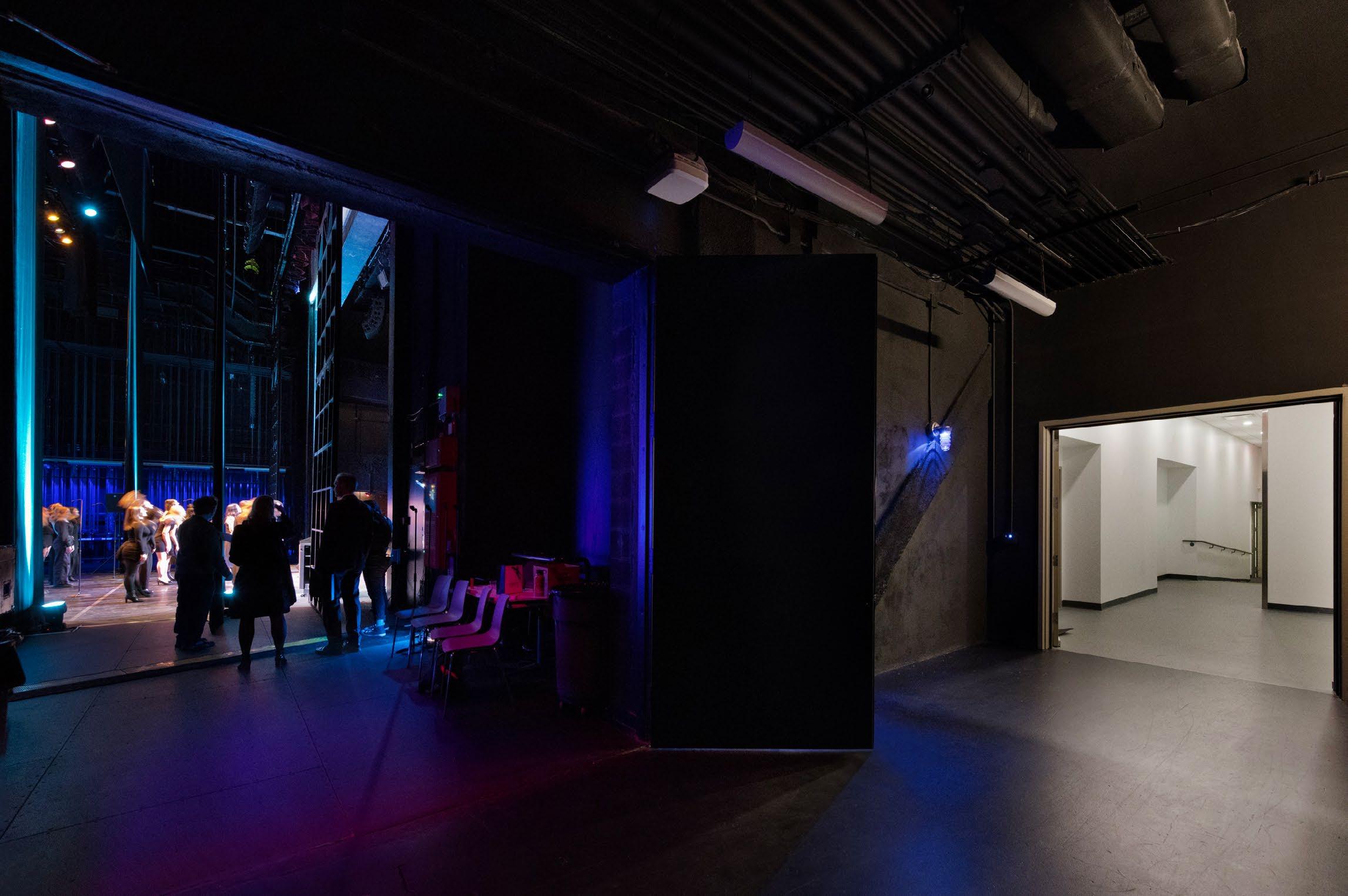
Iris Cantor Proscenium Theatre Back of House
Iris Cantor Proscenium Theatre

Troy, New York

Concert Hall
Acoustic Ceiling Plan



Leading-edge performing arts laboratory that brings together the arts, sciences, and technology under one roof
Designed to explore new technological innovations in the performing arts and provide the highest quality in acoustic and visual facilities, the new Experimental Media & Performing Arts Center (EMPAC) at Rensselaer Polytechnic Institute in upstate New York is a groundbreaking new resource to the institute. Precisely tailored to its complex program, EMPAC houses a 1,200-seat concert hall, a 400seat theater with a full fly tower, two adaptive environment (“black box”) studios including an audio and video production suite, artists-in-residence studios, a campus radio station, and a dance studio.
As the nation’s oldest technological university, with one of the first undergraduate programs in Electronic Media and Arts in the United States, RPI has further validated its position at the forefront of experimental media with this facility.
The design team took advantage of the site's challenging hillside location by positioning the facility's entrance at the highest elevation. From this easily accessible location, patrons descend through seven levels of the central atrium, which serves as the social hub of the building. The dramatic 1,200-seat Concert Hall — which combines the refined acoustics and comfort of great concert halls of the past with 21st century technology and flexibility — is wrapped inside a “hull” of curved cedar planks, which hovers inside a glass exterior, providing a practical and elegant enclosure for the hall's extensive mechanical and circulation corridors.

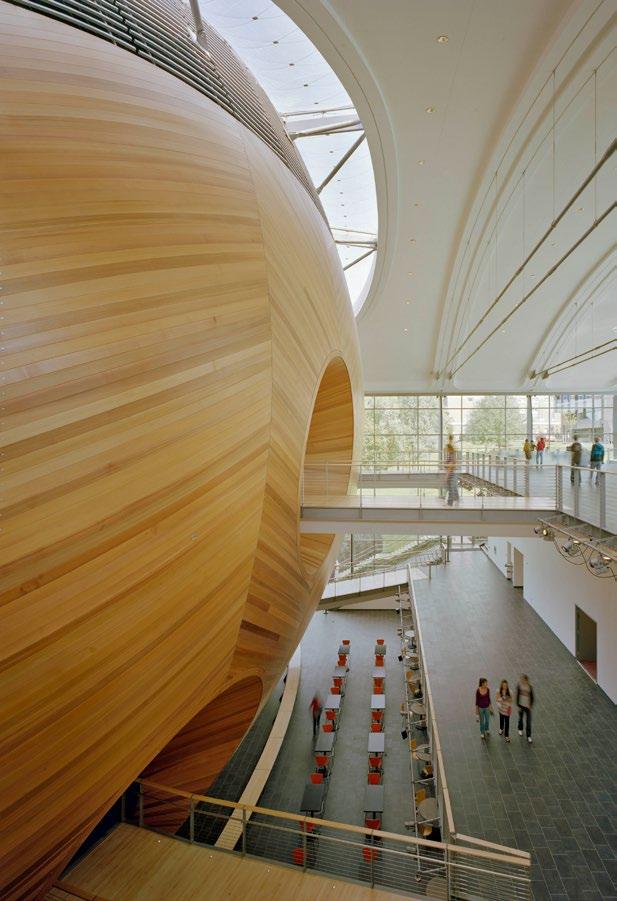

A true “black box” venue with minimal architectural finish, Studio 1 is well suited for audio and music while also seamlessly accommodating scientific visualization, multiscreen and immersive performances, and dance.
The immediate physical space can all but disappear; video projection can take place on all sides beneath a 40-ft ceiling that features a walkable theatrical grid over the entire surface of the room. The floors are finished in resilient wood and painted matte black. The walls are composed of adjustable acoustic wall diffusion panels and are also painted matte black. Studio 2 is a smaller sibling of Studio 1, and while well suited for dance and visual presentations, it is optimized for music recitals and recording and therefore has a “lights on” architectural character rather than being a black box. In addition to its tension wire grid ceiling, Studio 2 is finished with a resilient maple floor and ivory-colored adjustable acoustic wall diffusion panels.


Section perspective through 1200-seat Concert Hall
Preliminary concept sketch (Grimshaw and Partners)




1. 1,200-Seat Concert Hall
2. Central Atrium
3. 400-Seat End Stage Theater
4. Black Box Studio 1
5. Black Box Studio 2

James and Nancy Gaertner
Performing Arts Center
Sam Houston State University

The Gaertner Performing Arts Center provides dynamic performance spaces for Sam Houston University’s Dance, Music, and Theater departments. Distinctive sloped roofs identify each discipline’s performance hall, with pedestrian links to the existing theater and music buildings. A dramatic entry atrium welcomes visitors to a rich arts environment, complemented by commissioned works by Texas artists. The facility includes a concert hall, a recital hall, an outdoor performance area, a dance theater, three theater rehearsal studios, a body conditioning room, costume and scenery shops, and offices. Second-floor dance studios are cantilevered to allow access to ground level chilled-water lines. Bronze metal panels embellish the dance and music spaces, while brick and cast-stone accents reflect the material palette of the surrounding campus.



1. Second-Floor Dance Studio
2. Costume and Scenery Shop
Main Concert Hall

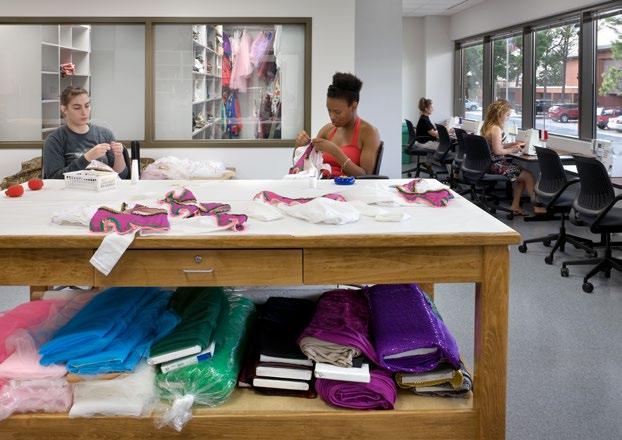
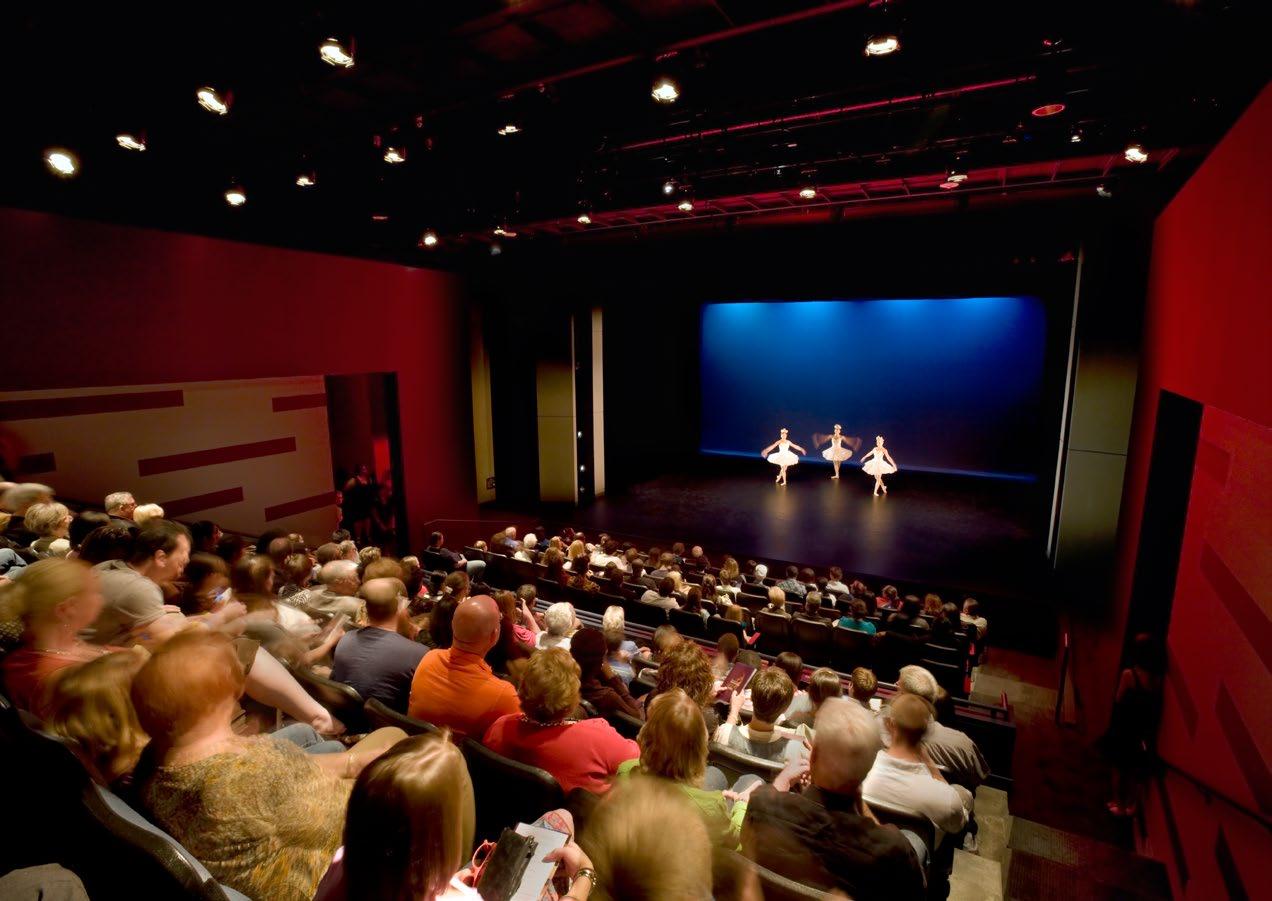








A
campus gateway to creativity and performance excellence
The new Academic Performing Arts Complex at the University of Texas Rio Grande Valley replaces two existing 40-year-old buildings with a new facility and includes the renovation of two adjacent structures. The dramatic 94,000-square-foot complex will greatly enhance the performance and rehearsal assets of the university’s Music Department as well as the capabilities of the larger Rio Grande Valley arts community.
The six primary spaces in the new building include a grand porch and lobby, which accommodate a variety of prefunction events; the primary 1,000-seat performance hall, which houses a range of music, dance, and theatrical events; and dedicated rehearsal spaces. The grand porch and lobby are oriented toward University Drive and downtown Edinburg at the southeast end of the campus, making this building a landmark gateway to the university from the city.
In order to re-establish the Arts Complex and bring it up to current performance standards we removed two buildings
and restored two others around an existing courtyard. We also added an entirely new structure that includes a 1,000seat performing arts auditorium, and four rehearsal halls — one each for band, mariachi jazz, vocal, and orchestra (as illustrated in floor plan below). The new complex creates a prominent and contextual gateway that the campus never had before, with a particular significance to the arts. The seminal idea for the complex was to make big masonry volumes with bold, lyrical openings in deference to the creative spirit of the building's occupants.
As visitors move through the building, slow transitions develop in terms of space and scale. There is an exterior layer of deep, welcoming porch with a broad wood soffit that is beautifully detailed and executed. Inside it, a second layer of lobby space wraps around the very strong brick volume that marks the performance hall.
The next layer, inside the brick volume, is full of passages to seats on the upper levels and is lit dramatically from above. The center of all these donut layers is the hall itself, which is full of warm wood and rich color. The acoustics are worldclass; the entire space is highly tunable and can be altered according to music type.


Passage to upper-level seats
Orchestra Rehearsal Room
Brick volume marking the performance hall
Ground Floor Plan
Main Performance Hall Section
University / New York, New York
Lenfest Center for the Arts

Planning and programming for creative exploration in performing arts, visual arts, film, and writing
The School of the Arts at Columbia University is an artistic and intellectual laboratory in which students work, experiment, and learn under the guidance of outstanding professors acclaimed in their fields of practice. The School offers graduate programs in Film, Visual Arts, Theater, and Writing and takes advantage of the extensive resources of the university and New York City as a whole. In support of its expanding arts program, Columbia engaged the New York office to prepare a Space Planning and Programming Study to identify space requirements and facilities — both new and renovated — that would allow the school to meet current shortfalls in space, consolidate far-flung outposts, and reduce or eliminate its reliance on rented venues. In addition to the School’s educational programs, the study
explored the relocation and expansion of the Wallach Gallery, the University’s fine arts gallery, as well as renovations to the Miller Theater which offers public programs in music, theater, and dance.
A key component of the study was the development of a new arts building — originally dubbed the “Lantern” — which would be a beacon for the university's new Manhattanville campus, providing flexible space for performance, film, rehearsal, and creative experimentation. The Lantern concept found its final form in the Lenfest Center for the Arts which serves multiple functions as the new home to Columbia’s cutting-edge arts program. The unique program and constraints of the site led to an innovative vertical organization of a performing arts center. The Lenfest Center contains a state-of-the-art 150-person film screening room and a 120-person flexible performance “black box” theater; it also houses the relocated Wallach Art Gallery and accommodates a penthouse events space.
Columbia



Lenfest Center for the Arts (left) Jerome L. Greene Science Center (right)
Columbia School of the Arts Planning Study Conceptual Section
Lenfest Center for the Arts Black Box Theater

The siting of the Lenfest Center is acoustically challenging, next to an above-ground subway train. Detailed acoustic and vibration analyses resulted in the use of special methods for controlling sound. A ‘box within a box’ construction method and floating slab technology were employed to achieve complete structural and acoustic isolation from one space to the next. This innovative vertical approach allowed for the isolation of many distinct program spaces in an efficient fashion. The 24-ft floor to floor heights at the three main levels also allow for easy modification of the venues to accommodate requirements of future uses.
The ground level contains the building entry and lobby, with all other program elements above or below grade to ensure maximum openness to pedestrians and the public.

1. Flexible Skylight Gallery
2. Wallach Gallery for the Arts
3. Black Box Theater
Film Screening Theater






The Perelman Performing Arts Center (PAC NYC)

Artistry meets technology — an innovative and highly-transformable space for the performing arts in Lower Manhattan
A key component of the master plan to rebuild the World Trade Center site following the attacks on September 11, 2001, the Perelman Center for Performing Arts (PAC NYC) creates approximately 135,000 sf of space for theater, dance, music, film, and opera in Lower Manhattan, becoming an anchor for the arts community. The building's exterior form is an internally-illuminated cube supported on a stone base. Its simple massing is a counterpoint to the diverse forms of the site’s redevelopment, as the building occupies a prominent location, bordering the National September 11 Memorial Plaza and One World Trade Center.
New York, New York

PAC NYC is designed to be highly adaptable, capable of being reconfigured into theaters of different scales. These range from 100-seat intimate in-the-round or 1,200-seat, 2-balcony, raked, end thrust layouts. These transformations utilize a trap equipped with removable platforms and seating lifts, four movable seating towers, vertically-retractable guillotine doors and demountable balconies. Individually, the theater base seating capacities are 100, 427, and 737. When combined, the capacity is 1,200 seats.
Supporting the theaters, PAC NYC has a rehearsal room that epitomizes the flexibility inherent to the facility. It is truly a multi-purpose space, outfitted to function as a performance space, acoustically separated to function as a fourth venue, and located to function as a social gathering space for performance intermissions.
The rehearsal room allows PAC NYC’s patrons to truly see behind the curtain at the inner workings of a performing arts center. The lobby was developed to be open and welcoming. It is spatially organized around a prominent stage platform, provided to encourage spontaneous, impromptu performances by patrons and the community.
PAC NYC is a technically-sophisticated and highly transformable facility. Challenges of this project included the need for movable primary building system components, acoustic and vibration isolation, highly prescriptive protective design and life safety requirements, and the accommodation of third-party MEP systems. Page actively led the process to find solutions to these challenges with the Owner, Theater Consultants, and the Port Authority of NY and NJ which has regulatory control of the site.

Motorized Lift Systems
These pistons allow the theater stage and floor to be quickly reconfigured from flat floor to stepped seating in a highly flexible way


Selected theater configurations
Transformable Theaters
PAC NYC can be reconfigured into theaters of different scales ranging from 100-seat intimate in-the-round or 1,200-seat, 2-balcony, raked, end thrust layouts. These transformations utilize a trap equipped with removable platforms and seating lifts, four movable seating towers, vertically-retractable guillotine doors and demountable balconies.






(above) Wraparound Marble Hall (below) Theater in the Round







Oprah Winfrey Theater
National Museum of African American History and Culture

1

Serving the community: a venue for dynamic performance and cultural enrichment
The Oprah Winfrey Theater at the National Museum of African American History and Culture is located below ground, opening directly into Concourse C of the museum's History Galleries. The main theater entrance is off the main lobby, down a great circular steel staircase. The 355-seat theater is designed to accommodate a variety of uses. It features a proscenium stage and an auditorium that are both 50 feet wide. The stage itself is approximately 23 feet deep, and the room extends 90 feet in length, with a ceiling height ranging from 23 to 27 feet.
The theater has become a local and national cultural center — home to myriad events including symposia, curator talks, conferences, corporate meetings and presentations, awards ceremonies, live theatrical performances, dance, live music from jazz to string ensembles, feature films, documentaries, archival media in a variety of formats, and other special

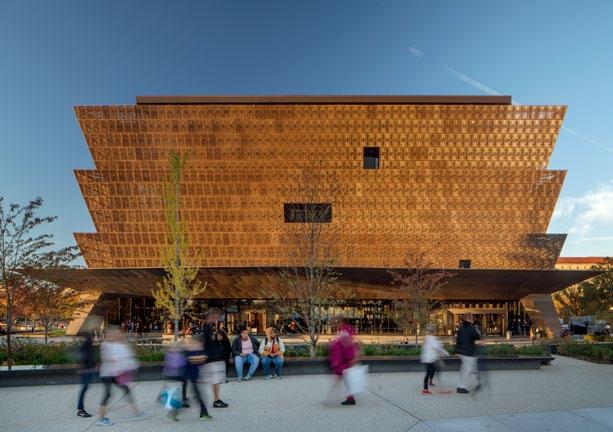
programming. Free public screenings of a wide array of films, including nationally premiering works from first-run studios, independent films, restored classic works, hard-to-find restored films, and works from the museum’s permanent collection, are hosted at the theater by the Stafford Center for African American Media Arts (CAAMA), often followed by lively post-screening discussions.
The venue was prioritized by the design team for early completion in order to host the museum's opening day festivities, concerts, and lectures. Aesthetically, the theater interior echoes the architectural themes that characterize the rest of the building, with acoustic panels bearing the distinctive form and pattern of the building's distinctive corona, which was inspired by the ornate ironwork of Charleston, Savannah, and New Orleans, much of which was created by enslaved and free African Americans. “It’s a jewel box of a space,” says Peter Rosenbaum of FDA, our acoustic and AV consultant. “People kind of gasp when they walk in,” says Keith Madden, the theater director. “It’s not ostentatious, just gorgeous.”

1. Lobby stair
2. Oprah Winfrey Theater
3. Museum south façade
Lobby & Theater



The Palace Theatre
Master Plan and Renovation



A timeless revival — blending historic elegance with contemporary performance
Constructed in 1931 and listed on the National Register of Historic Places in 1979, this restored RKO theatre is a vibrant cornerstone of Albany’s arts and entertainment scene. Guided by the Historic Structure Report we completed in the 1980s, Page carried out the renovation and restoration in two phases, working within tight timelines during the theater’s off-seasons.
Phase One included restoring the building envelope and architectural elements, plus an interior refresh with new carpeting, stage curtains, and fabric wall treatments. The original decorative ceiling finishes, hidden under cocoa-brown paint, were uncovered to reveal historic murals. The theater's damaged ornamental plaster was meticulously repaired, reviving its gilding, glazing, stenciling, and vibrant painting. The 2,800 seats, designed by famed movie palace architect John Eberson, were restored to their former grandeur. Matching fabrics and draperies were replaced with designs inspired by the originals.

MEP systems were also upgraded to meet the theater's needs. At the time of the restoration, the facility still used one of the first dimming racks built by General Electric. Page replaced this outdated system and upgraded lighting fixtures, control consoles, and power distribution.
Phase Two renovations included improvements to both the front and back of the house. For patrons, this meant a larger lobby, a donor room, an expanded concession area, and a newly positioned box office. Most notably, a new, energyefficient, full-color replica of the 1931 marquee was installed, with costs covered by an NYSERDA grant.
Expanding the theater's performance offerings, the stage was deepened to accommodate first-run Broadway shows. The backstage also received upgrades, including new dressing rooms, an elevator, loading areas, and additional storage and rehearsal spaces.
Once a bustling movie palace, the Palace Theatre has been rejuvenated as a prime venue for musicals, plays, concerts, and comedians in New York state's capital.


Yo-Yo Ma at the opening ceremonies of the renovated theater
Fabrication of new, energy-efficient replica of the 1931 marquee
Renovated exterior at night
Construction of new marquee



Creating connections — a dynamic venue for cross-cultural collaboration and artistic expression
The Irish Arts Center (IAC) is a home for cultural exchange with Ireland, a place for creation and development of new productions, a venue that supports cross-collaborations between US and Irish artists in many disciplines, and a center for educational programs that serves both the IrishAmerican and larger community. For most of its existence, the IAC operated out of a converted three-story tenement building, whose ground floor garage was transformed into a small theater. Our new expansion develops an adjacent existing building on 11th Avenue which is connected to the original facility, creating a center with two venues, as well as associated support, classroom, and rehearsal space.
The renovated and expanded 21,700 sf Irish Arts Center will house a 199-seat flexible theater, rehearsal studio classroom, multi-purpose classroom, exhibit areas, and a café as well as the restored 99-seat historic theater. The new IAC will provide spaces for collaboration among the creative disciplines of music, theater, dance, film, comedy, literature, and the visual arts. The new theater, used for drama, spoken word, and music, was designed to provide a flexible and neutral backdrop for set design while retaining a distinct character
for concerts. The solution included integrating dark-stained, sacrificial plywood panels, which allows for the adaptability of a black box while providing a sense of warmth and richness when the lights are on.
The multi-purpose classroom provides literature, language, distance-learning, music, and dance instruction and can also host events such as VIP theater functions and community meetings. Additionally, a robust public spaces program includes a café, gallery, lobby, and atrium spaces supported by infrastructure that allows these spaces to accommodate visual arts, live performances, and community events.



Flexible Theater configurations


Main Entry Lobby
Café
Lobby Atrium
Flexible Theater
Control Booth
Back of House
Classroom
Rehearsal Room
Side Entry Lobby


Daisy places high importance on deeply understanding all aspects of a project and is always looking for ways to improve projects by thinking outside the box. Her work in New York, London, and Paris has given her a global awareness of design and construction, including insight into cultural methodologies that influence architectural practices in the US and abroad. She most recently applied this knowledge in the programming and design of the diverse performing arts spaces at NYU’s Paulson Center, which she started working on in its early programming and conceptual design phases and led into the final phases of construction. The 735,000 sf, mixed-use facility provides 210,000 sf of new facilities for the performing arts.
Significant projects: The Center for Arts & Innovation Boca Raton, Florida • NYU John A. Paulson Center Warehouse Theater, African Grove Theater, and Iris Cantor Theater New York, New York • United States Embassy, Mexico City, US Department of State OBO Mexico City, Mexico

Will leads the design of many of Page's major performing arts, science, and technology projects, with a particular focus on research and performance facilities for academic and institutional clients. His work involves technological innovation in design to create high-quality spaces that encourage interdisciplinary rehsearch and interaction. He is particularly interested in how buildings can be designed to offer lasting value, optimize performance, be sustainable and energy efficient, and provide versatile spaces that encourage interaction and collaboration.
Significant projects: NYU John A. Paulson Center New York, New York • The Center for Arts & Innovation Boca Raton, Florida • Columbia University, Greene Science Center & Lenfest Center for the Arts New York, New York • RPI Experimental Media and Performing Arts Center (EMPAC) Troy, New York • Columbia University, Northwest Corner Building New York, New York • Princeton University Neuroscience & Psychology Building Princeton, New Jersey

Principal Newt Kershner AIA
Newt brings over 19 years of diverse experience designing for cultural and institutional clients in New York City and abroad, including the National September 11 Memorial Museum, the Frick Collection, and the new Zero Irving Technology Hub, as well as several cultural and transportation projects in Hong Kong, China. His approach to achieving design excellence for all of his projects is through embracing the range of contexts in which they occur. He recently designed the Irish Arts Center, a new cultural center dedicated to promoting the vibrant image of Ireland and Irish America through performance, exhibition, and education.
Significant projects: Irish Arts Center, New York, New York • US GSA Degetau Federal Building and Nazario US Courthouse Hato Rey, Puerto Rico • Columbia University School of the Arts Space Planning & Programming Study New York, New York • NYCEDC, Zero Irving Tech Hub New York, New York • Lower Manhattan Cultural Council, Building 110 Artist Studios, Governor’s Island New York, New York

Carl creates places that connect people to the cultural context and history that are bound into their physical settings. His award-winning designs are widely recognized by his peers and influential in advancing the practice of architecture. His work responds to the unique challenges of sensitive neighborhoods, often involving beloved landmark structures. A significant aspect of this is the engagement of broad constituencies including public agencies, elected officials, civic groups, and preservation advocates. He understands the challenges of modern programming and technology, and works creatively and collaboratively to re-imagine structures to support the client’s mission.
Significant projects: NYU John A. Paulson Center New York, New York • Irish Arts Center New York, New York • National September 11 Museum New York, New York • The Frick Collection Master Plan and Portico Gallery New York, New York • Columbia University School of the Arts Space Planning & Programming Study New York, New York
Principal Carl Krebs
Principal Daisy Houang
50 21
More than 50 Versatile Theater & Performing Arts Spaces
21 Design-Led Offices Nationwide and in Mexico City +
258 Certified LEED Projects + 98 Certification Projects in Progress
Featured Theater & Performing Arts Facilities
1 New York University John A. Paulson Center / New York, NY (Designed w/ KieranTimberlake)
210,000 sf of performing arts spaces incl. Warehouse Theatre (150 seats) • African Grove Theatre (150 seats) • Iris Cantor Theatre (350 seats) • Orchestra rehearsal room
2 RPI Experimental Media Performing Arts Center (EMPAC) / Troy, NY (AOR w/ Grimshaw)
Concert hall (1200 seats) • End-stage theater (400 seats) • Black box theater (150 seats)
3 Sam Houston State University Gaertner Performing Arts Center / Huntsville, TX
Concert hall (800 seats) • Recital hall (175 seats) • Dance theatre (150 seats) • Outdoor performance space • Dance studios, practice & dressing rooms, scene/costume shops
4 University of Texas Rio Grande Valley Performing Arts Complex / Edinburg, TX
Performing arts auditorium (1,000 seats) • Rehearsal spaces for band, orchestra, choir, mariachi/jazz ensembles
5 Columbia University Lenfest Center for the Arts / New York, NY (AOR w/ RPBW)
Flexible theater (120 seats) • Screening room (150 seats) • Wallach Gallery • Multi-purpose room (200 seats)
6 The Perelman Center for the Performing Arts at the World Trade Center / New York, NY (AOR w/ REX) 1200+ total capacity in flexible configurations incl. Theaterin-the-Round (427 seats) and Intimate Theater (99 seats)
7 Oprah Winfrey Theater, National Museum of African American History and Culture / Washington, DC (Designed as Freelon Adjaye Bond, w/ SmithGroup)
Multi-purpose theater (350 seat) for performances, screenings, symposia, and cultural events
8 The Palace Theatre Renovation / Albany, NY 2,800-seat restored deco-era theater • Expanded lobby, dressing rooms, elevator, add'l storage and rehearsal areas
9 Irish Arts Center / New York, NY
Flexible theater (199 seats) • 74-seat ‘historic’ theater • Support facilities incl. rehearsal studio classroom, multipurpose classrooms, exhibit areas, and café
Selected Theater & Performing Arts Facilities (Completed or in Progress)
• Dartmouth University Hopkins Center for the Arts / Hanover, NH (in progress, AOR w/ Snøhetta)
900-seat theater with augmented technology for sharing performances around the globe • Multiple performance venues, studios, workshops, and rehearsal spaces
• The Center for Arts & Innovation / Boca Raton, FL (in progress, AOR w/ RPBW)
Public event, performance, and education spaces with a capacity of 6,000 visitors • 100-person rooftop panoramic space • 100,000 sf of solar panels
• MIT Kresge Auditorium & Chapel / Cambridge, MA
Renovation of two historic Eero Saarinen buildings incl. Concert Hall (1,200 seats) • Small theater (177 seats) • Two rehearsal rooms • Dressing rooms • Restored MIT Chapel
• Greenhill School, Marshall Family Performing Arts Center / Addison, TX (AOR w/ Weiss Manfredi)
Proscenium theatre (600 seats) • 3,000 sf black box theatre, rehearsal studio & support facilities • Dance and recital hall • Green room • Dressing rooms and costume shop • Video and film production classrooms
• Bowie State University Fine and Performing Arts Center / Bowie, MD
Main stage theater (400 seats) • Black box theater (200 seats) • Movement studio (90 seats)
• NYU Cantor Film Center / New York, NY
Large theater (260-seats) • Two 125-seat screening rooms
• Dallas County Community College District Mountain View College / Dallas, TX
Major renovations to the 434-seat Mountain View College theatre including: reconstruction of sound, lighting control, and projection booths, new fire separation wall; main lobby
• Greer Garson Theatre & Other Arts Venues, Southern Methodist University / University Park, TX
Greer Garson Theatre (394 seats, thrust stage) • Archives
Screening Theaters • O’Donnell Lecture/Recital Hall (182 seats): The Taubman Atrium • Sharp Performing Arts
Studio (black box / ballet) • Ballet studio
• SMU Owen Fine Arts Center / University Park, TX
Electronic keyboard studio • Electronic music studio • Fine Arts Center music therapy suite • Psychoacoustics lab • Piano rehearsal studios
• Lewisville Center for the Creative Arts / Lewisville, TX
Performance hall (297 seats) • 3,000 sf black box theatre • 13,000 sf performance courtyard
• American Museum of Natural History, Gilder Center for Science, Education, and Innovation / New York, NY (AOR w/ Studio Gang)
360° Immersion Experience Theater
• Jacob Burns Film Center / Pleasantville, NY
Large cinema (145 seats) • Screening room (70 seats)
• Walter Reade Theater, Film at Lincoln Center / New York, NY
State-of-the-art film-screening theater (270 seats, including 18 removable to accommodate wheelchairs)








Architecture
Engineering
Theater Programming
Master Planning / Visioning
Preservation / Modernization
Community Engagement
Branding
Experiential Graphic Design
Signage / Wayfinding
With inquiries, contact:
Daisy Houang
AIA
Principal dhouang@pagethink.com 212 633 4727
Newt Kershner AIA
Principal nkershner@pagethink.com 212 633 4754
Will Paxson AIA
Principal wpaxson@pagethink.com 917 331 6268
Carl Krebs FAIA
Principal ckrebs@pagethink.com 212 633 4739




